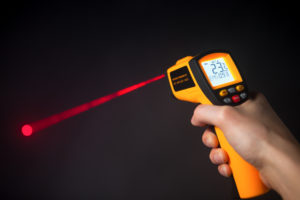Inspection Gadgets

 Advances in imagining and sonic technology have long been embraced by engineers and are being used every day to help evaluate buildings and building systems. These gadgets can allow for an in-depth, minimally invasive, and cost-effective inspection with rapid results. Plus, it is fun to pull out a toy that you might see in an action movie to help figure out a problem. The following are found in most local consultant’s arsenals.
Advances in imagining and sonic technology have long been embraced by engineers and are being used every day to help evaluate buildings and building systems. These gadgets can allow for an in-depth, minimally invasive, and cost-effective inspection with rapid results. Plus, it is fun to pull out a toy that you might see in an action movie to help figure out a problem. The following are found in most local consultant’s arsenals.
- Thermal Camera – Police, military, and ghost hunters use them and so do engineers. Infrared thermography allows us to “see” hot and cold areas and can allow for a rapid scan of a room, roof, electrical panel, radiator, or a building façade for thermal anomalies. These normally are found to be air and water leaks and help pinpoint locations that should be inspected more thoroughly. Blue areas are cold and red are hot.
- Drones – Unmanned flying aircraft now are easier to maneuver and can take high resolution digital video and photos, which allows for the inspection of a roof or building exterior when access is extremely difficult or limited. Government regulations are still in a state of flux related to this equipment, but the rules are getting clearer as time goes on.
- Ground Penetrating Radar – The same technology that allows police to scan a field for objects buried underground is used by engineers to emulate Superman and see what is in concrete. The 3-D version can generate an image of what is embedded in a concrete slab.
Impact-Echo – This device uses a special hammer and sound waves to measure the thickness of concrete and find buried defects that are not visible to the human eye by simply tapping the surface.
Moisture Meter – Used to measure the moisture content of wood, drywall, and other building materials to help narrow down if a water leak is active and where it may be coming from. - Boroscope – Spy movies show the hero inserting a fiber optic cable under a door or through an air vent to look into a room. Engineers use this same technology to look behind walls or under floors by drilling a small hole instead of making a large opening.
Infrared Thermometer – Allows an inspector to determine the temperature of an object without touching it. This is especially useful when checking to see if a wall is warm enough to be painted. - Ultrasonic Thickness Gauge – Measures the wall thickness of pipes or other metal objects using sound waves to help determine if they are corroded/damaged, inside, without having to remove a piece of the material.
While technology is great, we do not rely exclusively on the digital output. The best diagnostic tools we use are still those we are born with – eyes, ears, fingers, and brain. When an engineer combines their innate detective skills with modern gadgets, we begin to resemble a human Swiss Army Knife and can arrive at a solution for your building problem
